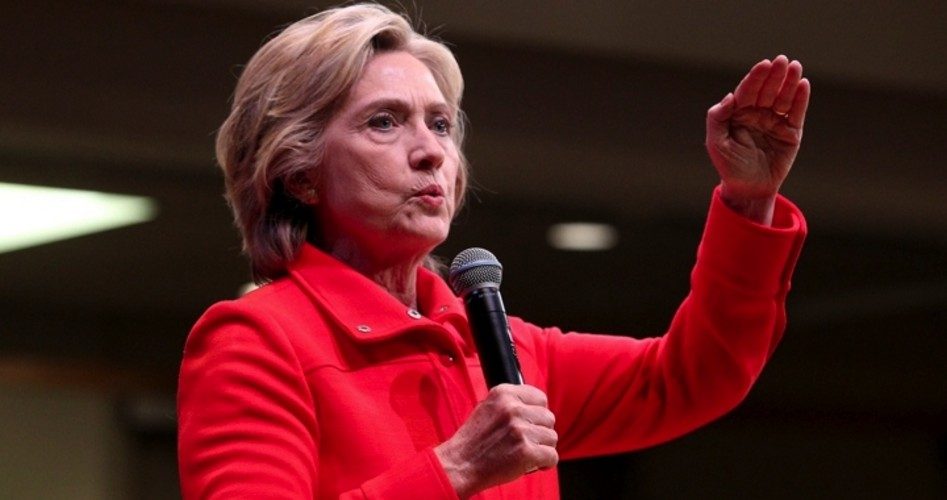
Would Hillary Clinton ban guns in the United States? She apparently supported the idea last Friday, but then supposedly dismissed it three days later. It’s the difference between an on- and off-Teleprompter candidate.
During an October 16 town hall meeting at Keene State College, a questioner asked Clinton if we could follow Australia’s lead and ban handguns. She replied that the nation’s confiscation of firearms was a “good example” and was “worth looking at” when formulating U.S. gun policy. Here’s more of her unguarded-moment answer:
You know, Australia’s a good example, Canada’s a good example, the UK’s a good example. Why? Because each of them had mass killings, Australia had a huge mass killing about 20 or 25 years ago. Canada did as well, so did the UK. In reaction, they passed much stricter gun laws. In the Australian example, as I recall, that was a buyback program. The Australian government as part of trying to clamp down on the availability of … weapons offered a good price for buying hundreds of thousands of guns and basically clamped down going forward, in terms of having more of a background check approach — more of a permitting approach.
Clinton went on to say about such a proposal, “It would be worth considering doing it on the national level.”
And what is this idea so profound it’s “worth considering”? As Business Insider’s Christina Sterbenz explained Oct. 11:
Aside from banning certain semiautomatic and self-loading rifles and shotguns, the [Australian] legislation required all firearm-license applicants to show “genuine reason” for owning a gun, which couldn’t include self-defense.
Aside from the NFA [National Firearms Agreement], Australia still had to remove the guns then on its streets and instituted a mandatory, federally financed gun-buyback program. [Emphasis added.]
So, a gun law including mandatory confiscation and discounting self-defense as a legitimate reason for gun ownership — and the Democrat front-runner was all for it.
Yet just three days after the Keene town hall, the Clinton campaign would walk back the comments. Campaign spokesman Jennifer Palmieri told MSNBC’s Andrea Mitchell that Clinton wasn’t supporting gun confiscation and has merely proposed “very common-sense measures the majority of the public supports.”
This backtracking isn’t surprising. When Al Gore lost the 2000 presidential election to George W. Bush by a razor-thin margin, some observers noted that his gun-control advocacy might have cost him a rural state or two and tipped the balance. Also note that while the United States. has been steadily drifting “Left,” gun rights constitute one of the two issues (the other is prenatal infanticide) where polls show the electorate has actually shifted “right.” Thus, honesty on the issue is a political third rail for Democrats.
The problem with the prepared-statement Clinton’s denial of the from-the-heart Clinton’s comments is not just its obvious damage-control nature. It’s that the Australian model is much admired on the Left and is precisely what a keen observer would expect Clinton to believe. As the aforementioned Sterbenz put it, the Australian “changes remain the gold standard for advocates of gun control today.”
So not surprisingly, other prominent politicians and media outlets see this gold’s supposed glitter. NBC News wrote an Oct. 2 piece shilling for Australian-like changes, and in it quoted Clinton’s ex-boss:
President Barack Obama, who has been frustrated in his attempts to tighten gun control, praised the Australian reforms in the days after the Charleston massacre.
“When Australia had a mass killing … it was just so shocking the entire country said, ‘Well, we’re going to completely change our gun laws,’ and they did. And it hasn’t happened since,” he told comedian Marc Maron.
Yet the reality is that whether the Australian model or some other, gun control does not equate to crime control. Here are some firearms facts generally overlooked by the media:
• As The Federalist wrote in September, “Manslaughter, sexual assault, kidnapping, armed robbery, and unarmed robbery [in Australia] all saw peaks in the years following the ban, and most remain near or above pre-ban rates.”
• Suicides in Australia are at a 10-year high.
• The Australian murder rate declined substantially post-ban, as Australians’ number of legal firearms decreased. Yet the U.S. murder rate also declined substantially during the same period, as Americans’ number of legal firearms increased.
• Obama recently stated that no other advanced nation experienced our level of mass killings. Untrue. In terms of mass killings relative to population, the United States actually ranks behind five nations, including Norway and Finland — which both have firearms regulations labeled “Restricted.”
• While the United States is portrayed as a Wild West, it actually ranks only 98th in homicide rate among 194 nations, placing it in the bottom 50 percent.
• A recently publicized gun study, conducted by two criminologists and published in the Harvard Journal of Law & Public Policy, found that there is “a negative correlation” between guns and violence. In other words, “Where firearms are most dense violent crime rates are lowest, and where guns are least dense, violent crime rates are highest.”
Examples of the above abound:
1. There are nations with far stricter gun-control laws than the United States but higher murder rates; Russia, Mexico, and Brazil are examples. There are also countries with high gun-ownership rates but very little homicide, such as Israel and Switzerland (which has the world’s ninth-lowest murder rate).
2. Japan, which has strict gun control, “technically” has the world’s fifth-lowest homicide rate. Yet Japanese-descent Americans living in the United States — under our relatively lenient gun-control laws — have a murder rate half that of Japanese living in Japan.
3. The state of New Hampshire has a higher gun-ownership rate than the United Kingdom but also a lower murder rate.
4. As Dr. Thomas Sowell wrote in 2012, “The rate of gun ownership is higher in rural areas than in urban areas, but the murder rate is higher in urban areas. The rate of gun ownership is higher among whites than among blacks, but the murder rate is higher among blacks.”
Demographics appear to be the greatest influence on murder rates. One reason the U.S. rate has declined in recent times is that the proportion of the population represented by young people — the age demographic most criminally inclined — has also declined.
What has not declined is the simmering but often secret gun-control zeal of the Left. It doesn’t bubble to the surface much during election time, but elective-office security can loosen lips. As Senator Dianne Feinstein said on CBS-TV’s 60 Minutes on February 5, 1995, while commenting on the incorrectly termed “assault-weapons ban”: “If I could have gotten 51 votes in the Senate of the United States for an outright ban, picking up every one of them — Mr. and Mrs. America, turn ’em all in — I would have done it. I could not do that. The votes weren’t here.”
But if and when the votes are there, it will be a different story. Leftists simply don’t believe in Second Amendment rights — no matter what they say on the campaign trail.
Photo: AP Images


